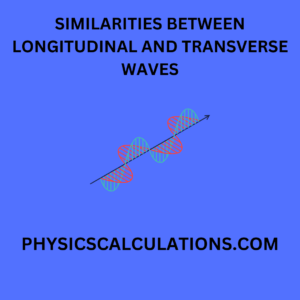Similarities Between Transverse and Longitudinal Waves

Here are 15 similarities between transverse and longitudinal waves:
- Both transverse and longitudinal waves are mechanical waves. They require a medium to pass through.
- The two types of waves transfer energy from one point to another without the transfer of mass.
- They also have a frequency and wavelength that determines the speed of the wave.
- Both waves are produced by a vibrating source that sets the medium into motion.
- Additionally, they can interfere with each other. This interference will later result in the creation of standing waves.
- They also have the ability to reflect off surfaces and refract as they pass through different media.
- The two waves are characterized by their amplitudes, which determine the height of the wave.
- Both types of waves can be measured and described using wave properties. These wave properties include wavelength, frequency, and velocity.
- Transverse and longitudinal waves can be graphed as waveforms to illustrate their shape and behavior.
- They can be superposed, which can cause complex wave patterns.
- The two waves can be applied in communication and medicine.
- These waves can be generated by natural processes such as earthquakes and sound.
- Transverse and longitudinal waves can be analyzed mathematically using wave equations and theories.
- They can be described by their polarizations, which determine the orientation of the wave.
- Both types of waves can be transformed into other forms of energy, such as heat or electricity.
You may also like to read:
The amplitude of a lightly damped oscillator decreases by 3.0% during each cycle.
What is the Magnification of the Ocular Lens?
How to Calculate Total Magnification
An Object is 1.0 cm tall and its inverted image is 5.0 cm tall. what is the exact magnification?
Sources: